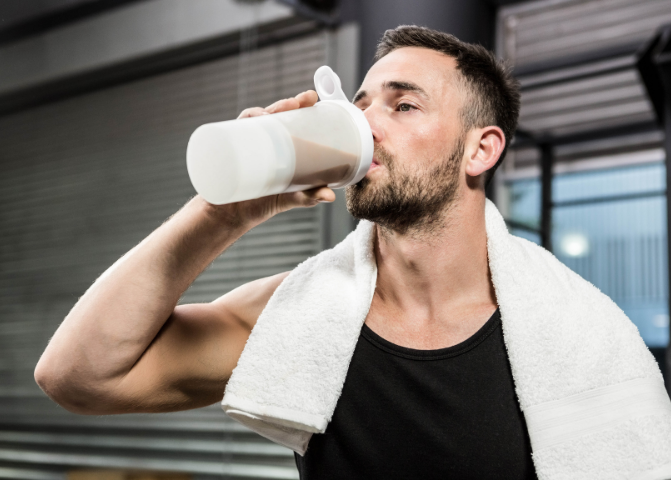26/10/2021
Protein – Learn About High Protein Foods And Supplements
Table of Contents
- How High-Protein Foods Help With Weight Loss?
- What Foods Are High In Protein?
- How Much Protein You Should Eat Daily?
- How Much Carbohydrates and Fats You Should Consume?
- How to Keep Track Of Your Macronutrients?
- What Are The Different Types of Protein Powder?
- What Is The Best Protein Powder For Women?
- How to Combine Protein Powder With An Exercise Program
High protein foods- what are they and how are they beneficial for weight loss? Below we present some of the facts regarding this macronutrient including recommended daily intakes and combining protein powder with exercise.
Protein is one of the most popular macronutrients talked about today. But despite that, or possibly as a result of it, there is a lot of misinformation surrounding protein.
To that end, we’ve put together this guide to help you understand protein sources and gain some practical knowledge.
So, if you’re interested in learning about protein, its role in weight loss, how much you should eat, how to supplement with it, and more, read on.
We are breaking down everything you’ll ever need to know about protein.
How High-Protein Foods Help With Weight Loss
Prevailing wisdom suggests that weight loss occurs from doing lots of physical activity and eating mostly vegetables. While that’s certainly one way to get the job done, optimal weight loss requires protein.
Consuming enough protein is always important, especially when looking to shed fat. The nutrient helps with weight loss in three unique ways:
1) Protein provides us with the building blocks we need to maintain optimal protein turnover rates and keep our muscles. As a result, we can lose primarily fat and achieve a lean and athletic appearance more easily.
2) Protein has a slightly higher thermic effect. Unlike fats and carbs, protein has a thermic effect of 20 to 35 percent. Meaning, for every 100 calories you get from protein, your body expends 20 to 35 calories to break down the protein and absorb its amino acids.
3) Protein-rich foods tend to be more satiating, which allows us to feel fuller between meals and stick to caloric restriction.
In any case, there is more to successful weight loss than eating enough protein. If you’re interested in expanding your knowledge, read our post: How to lose weight – a comprehensive guide.

What Foods Are High In Protein
Since protein plays a huge role in our health, well-being, and training results, we need to get enough of it each day. The question is, what foods are high in protein? Let’s take a look at some foods and their respective protein per 100 grams:
- Red Meat – 25 to 30 grams
- Fish – 20 to 27 grams
- Poultry – 25 to 31 grams
- Eggs – 13 grams
- Cottage cheese – 11 to 13 grams
- Greek yogurt – 10 grams
- Shrimp – 24 grams
- Quinoa – 16 grams
- Ezekiel bread – 15 grams
- Nuts – 20 to 25 grams
- Seeds – 20 to 30 grams
- Oats – 13 grams
How Much Protein You Should Eat Daily
As you’ve probably noticed, protein recommendations vary wildly. You could see a recommendation as small as 0.8 grams of protein per kilo of weight to as much as three, even four grams per kilogram. For example, if you weigh 70 kilograms, one source might recommend eating 56 grams of protein daily and another – 210+ grams.
Like with most things, the truth is somewhere in the middle. Conservative recommendations are only good for preventing protein deficiency, but eating too little of the nutrient prevents us from reaping its benefits. In contrast, too much protein doesn’t do much for us because the body has a limit of how much protein it can use productively.
So, a recommendation of 1.6 to two grams of protein per kilogram seems best for most people. That would mean eating 112 to 140 grams of protein daily if you weigh 70 kilograms.
How Much Carbohydrates and Fats You Should Consume
Aside from determining your daily protein goal, you should also eat enough carbs and fats. Both nutrients play essential roles inside the body, contribute to our well-being, and keep us healthy. For example, fats are crucial for things like:
- Hormonal production
- Brain health
- Cell integrity
- Organ protection
Carbs are also important for:
- Providing us with energy
- Replenishing muscle and liver glycogen (a form of fuel we store for later use)
- Aiding brain function and cognition
And more.
As a rule of thumb, you should first determine your protein intake, which we did above. You then have to calculate fats. Your fat intake should be around 0.6 to 0.7 grams per kilo of body weight. If you weigh 70 kilograms, aim for 42 to 49 grams of fat daily.
Once we have protein and fat goals, our remaining calories for the day should come in the form of carbs. For example, if you’ve determined that your daily calories should be 2,300 calories and you weigh 70 kilos, it would look like this:
- 112 to 140 grams of protein
- 42 to 49 grams of fats
- Remaining calories from fats
We recommend tracking protein, fats, and your overall calorie intake. So long as you do that, your carbs will naturally sort themselves out.
How to Keep Track Of Your Macronutrients
Downloading an app like MyFitnessPal is a great option for tracking your macronutrients. The process looks like this:
- Download the app
- Make an account
- Fill in personal information (gender, activity level, age, height, weight, goals, etc.)
- Start adding the foods you eat and their respective quantities
The great thing about such apps is that they do all the calculations for you, and you don’t have to worry about anything. They also calculate protein, fats, carbs, and micronutrients.
Alternatively, you can keep a classic food log to write down the foods you eat and their quantities. You then calculate your calories, proteins, and fats by hand. The approach also works, and it might be better for people who enjoy having a physical log instead of writing down everything on a digital device. The only downside is that you have to calculate by hand, which takes a bit more effort.
Regardless of the approach, you should have a kitchen scale to measure your foods and accurately track your calories and macronutrients. Eyeballing quantities can work, but you need some experience with weighing your foods to be accurate.

What Are The Different Types of Protein Powder?
Protein powders have become one of the most popular supplements today and for good reasons. They are versatile, effective, and convenient. Instead of eating lots of high-protein foods each day, you can replace some with a scoop or two of protein powder.
Whey and casein are the two most popular options, but we also have vegan and other options like beef and egg protein.
As the most popular option, whey protein comes in three primary categories:
- Concentrate – the more affordable option that boasts around 80 percent protein per dose. The remaining calories come from fats and sugars like lactose.
- Isolate – the expensive and more refined option that offers 90+ percent protein per dose. As a result, this type of supplement provides fewer grams of fats and sugars per scoop.
- Hydrolysate – a form of whey that goes through a process of hydrolysis. Long protein bonds get broken down into shorter chains, allowing for quicker absorption of the amino acids.
Casein is the other dairy-based protein. Unlike whey, casein forms into a gel once it travels to the stomach, slowing down the breakdown. The benefit is that we get a steady stream of amino acids for long after we’ve consumed it.
Vegan protein powders have also become quite popular these days. Hemp and soy are two of the most popular plant-based proteins, but you can get rice, pea, beans, and seeds. Most of these products blend different protein sources, which allows for a more diverse amino acid profile.
Beef and egg protein powders are also somewhat popular today, and both can work if you don’t want a dairy or plant-based product.
What Is The Best Protein Powder For Women?
There isn’t a single best protein powder for women. The person’s goals, preferences, and budget all play a role when making the decision.
For example, whey concentrate is a good option. The protein is affordable, offers enough protein, and generally tastes good. But if you have a sensitive stomach and feel bloated or nauseous, concentrate might not be ideal. Instead, you might choose whey isolate, which is the purer form that people tolerate better. Isolate is also beneficial because it provides fewer calories per scoop, which is helpful if you want to lose some weight.
Of course, a plant-based protein will be your only option if you follow a vegan diet. Pea, hemp, and soy are three great options.
How to Combine Protein Powder With An Exercise Program
You need to keep two things in mind for protein powder and exercise:
First, protein powder is beneficial no matter what type of exercise you do. Whether you enjoy running, playing sports, lifting weights, or something else, protein will support your recovery and help you make good progress.
Second, protein powders are good, but they should only supplement your diet. You still need to consume protein from foods because they provide other nutrients your body needs. Check out the list we shared above if you’re looking for some high-protein ideas.
One of your best options for combining protein powder with an exercise program is to have a post-workout shake. Your drink can consist of a scoop or two of protein and other ingredients, such as milk, peanut butter, banana, and similar. Having a shake after your training will kickstart the recovery process, allowing you to build more muscle in the long run.
Recommended reading
Search for a specific topic or filter by categories to find information on what you need to know on the full Medmate Journal

What to Do When You’re Unwell at Home: A Practical Guide
Feeling unwell at home can be frustrating—especially when you can’t get in to see a doctor or you’re too unwell to leave the house. Whether it’s symptoms of a virus,…

